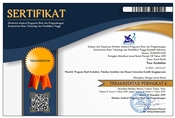PENERAPAN PRINSIP RESILIENCE ARCHITECTURE PADA HUNIAN SEMENTARA PASCABENCANA
Abstract
Abstract
The number of disasters in the last ten has only increased. However, this condition is not accompanied by a responsive government attitude to take steps to mitigate disasters. Temporary shelters as the government's efforts to deal with disasters in the field of rehabilitation and reconstruction only focus on the speed of development. Resilience architecture does not only focus on aspects of speed and accuracy of construction but also on aspects of sustainability to achieve a balance between economic, social and community regenerative growth through architectural design. This study aims to determine the extent to which the principles of resilience architecture are applied in the design of post-disaster housing, by analyzing the application of the concept of resilience architecture in the aspects of Efficiency and Effectiveness, Economical, Eco-tech and Sustainability, Durability, Flexibility. The research method used is Dynamic Mixed Methods with the Paired Comparison Rating Scale analysis approach by measuring and comparing several samples that meet the number of indicator items made. The results of research on several objects show that temporary housing is limited in responding to the aspects of accuracy, speed, and technology of the construction system, but in terms of environmental sustainability it still has not shown optimal results.
Keywords: Construction, Local-Oriented Design, Resilience architecture, Temporary Shelters
Abstrak
Jumlah bencana dalam sepuluh terakhir semakin meningkat. Namun, kondisi tersebut tidak dibarengi dengan sikap pemerintah yang tanggap untuk mengambil langkah penanggulangan dalam kebencanaan. Hunian sementara sebagai upaya pemerintah dalam menanggulangi bencana di bidang rehabilitasi dan rekonstruksi hanya berfokus pada kecepatan pembangunan. Resilience architecture tidak hanya berfokus pada aspek kecepatan dan ketepatan konstruksi namun juga pada aspek keberlanjutan untuk mewujudkan keseimbangan antara pertumbuhan ekonomi, sosial, dan regeneratif komunitas melalui desain arsitektur. Penelitian ini bertujuan untuk mengetahui sejauh mana prinsip resilience architecture diterapkan dalam perancangan hunian pascabencana, dengan menganalisis penerapan konsep resilience architecture pada aspek Efficiency and Effectivity, Ekonomis, Eco-tech and Sustainability, Durability, Flexibility. Metode penelitian yang digunakan adalah Dynamic Mixed Methods dengan pendekatan analisis Paired Comparison Rating Scale dengan cara mengukur dan membandingkan beberapa sampel yang memenuhi jumlah butir indikator yang dibuat. Hasil penelitian pada beberapa objek menunjukkan hunian sementara terbatas merespons pada aspek ketepatan, kecepatan, dan teknologi sistem konstruksinya, namun dalam aspek keberlanjutan lingkungan masih belum menunjukkan hasil yang optimal.
Kata kunci: Hunian Sementara, Konstruksi, Local-oriented design, Resilience architecture
Keywords
Full Text:
PDF (Bahasa Indonesia)References
Alam, P. C., Nurcahyanto, H., & Sulandari, S. (2013). Upaya Rehabilitasi dan Rekonstruksi Wilayah Pasca Bencana Erupsi Gunung Merapi di Kecamatan Kemalang Kabupaten Klaten Provinsi Jawa Tengah. Journal of Public Policy and Management Review, 2(3), 169–181. https://doi.org/https://doi.org/10.14710/jppmr.v2i3.3043
Asefi, M., & Sirus, F. A. (2012). Transformable Shelter: Evaluation and New Architectural Design Proposals. Procedia - Social and Behavioral Sciences, 51, 961–966. https://doi.org/https://doi.org/10.1016/j.sbspro.2012.08.270
Baibarac, C., & Petrescu, D. (2019). Co-design and urban resilience: visioning tools for commoning resilience practices. CoDesign, 15(2), 91–109. https://doi.org/https://doi.org/10.1080/15710882.2017.1399145
Behlert, B., Diekjobst, R., Felgentreff, C., Manandhar, T., Mucke, P., Pries, L., Radtke, K., & Weller, D. (2020). World Risk Report 2020-Focus: Forced Displacement and Migration. In Bündnis Entwicklung
Hilft. Bündnis Entwicklung Hilft. https://reliefweb.int/report/world/worldriskreport-2020-focus-forced-displacement-and-migration
BNPB. (2008). Peraturan Kepala Badan Nasional Penanggulangan Bencana No 11 Tahun 2008 Tentang Pedoman Rehabilitasi dan Rekonstruksi Pasca Bencana. In BNPB. https://bnpb.go.id/uploads/24/peraturan-kepala/2008/perka-11-tahun-2008-tentang-pedoman-rehabilitasi-dan-rekonstruksi-pasca-bencana.pdf
BNPB. (2019). Rencana Nasional Penanggulangan Bencana 2020-2024. https://bnpb.go.id/buku/rencana-nasional-penanggulangan-bencana-20202024
Creswell, J. W., & Creswell, J. D. (2018). Mixed Methods Procedures. In Research Defign: Qualitative, Quantitative, and Mixed Methods Approachesethods Approaches (Fifth). SAGE.
Félix, D., Monteiro, D., Branco, J. M., Bologna, R., & Feio, A. (2015). The role of temporary accommodation buildings for post-disaster housing reconstruction. Journal of Housing and the Built Environment, 30(4), 683–699. https://doi.org/https://doi.org/10.1007/s10901-014-9431-4
Groat, L. N., & Wang, D. (2013). Architectural Research Methods. Wiley.
Hadi, H., Agustina, S., & Subhani, A. (2019). Penguatan Kesiapsiagaan Stakeholder dalam Pengurangan Risiko Bencana Alam Gempabumi. Jurnal Geodika, 3(1), 30–40. https://doi.org/10.29408/geodika.v3i1.1476
Istiadji, D., Hardiman, G., & Satwiko, P. (2018). Studi Kerangka Konseptual Resilience Dalam Konstelasi Konsep Gerakan Lingkungan. Seminar Nasional Kearifan Lokal Dalam Keberagaman Untuk Pembangunan Indonesia, 7, 439–432.
Min-Seok, K., Jae-Seong, J., Tae-Jun, Y., & Mi-Jin, P. (2019). A Study on a Plan for an Assembly-Type Temporary Housing Facility Usable in Times of Disaster. Journal of Engineering and Applied Sciences, 14, 1430–1437. https://doi.org/http://dx.doi.org/10.36478/jeasci.2019.1430.1437
Nappi, M. M. L., & Souza, J. C. (2017). Abrigos temporários: um olhar arquitetônico sobre a relação entre usuário e ambiente. Arquitetura Revista, 13(2), 112–120. https://doi.org/https://doi.org/10.4013/arq.2017.132.05
Ningrum, A. S., & GInting, K. B. (2020). Strategi Penanganan Banjir Berbasis Mitigasi Bencana pada Kawasan Rawan Bencana Banjir di Daerah Aliran Sungai Seulalah Kota Langsa. Geography Science Education Journal (GEOSEE), 1(1), 6–13.
Oliver, A., Thomas, I., & Thompson, M. (2013). Resilient and regenerative design in New Orleans: the case of the Make It Right project. S.A.P.I.EN.S: Surveys and Perspectives Integrating Environment and Society, 6(1), 1–13.
Prasetyo, L., Tobing, R. R., & Budiyuwono, H. (2018). Konsep ekologis dan budaya pada perancangan hunian paska bencana di Yogyakarta. ARTEKS : Jurnal Teknik Arsitektur, 2(2), 125–136. https://doi.org/https://doi.org/10.30822/arteks.v2i1.46
Rahman, A. P., Listiani, A., Susanti, E., Halim, M., Sena, P. G., & Shafna, S. E. (2020). ANTARA: Antisipasi Bencana dengan Huntara (I. Kurniawan (ed.)). Penerbit Nuansa Cendekia.
Saiko, V. (2009). Specific Characteristics of Applying the Paired Comparison Method for Parameterization of Consumer Wants. Anale. Seria Informatică, VII, 305–314.
DOI: https://doi.org/10.24167/tesa.v20i2.5234
ISSN 1410-6094 (Print) | ISSN 2460-6367 (Media Online) | View My Stats

This work is licensed under a Creative Commons Attribution 4.0 International License.









